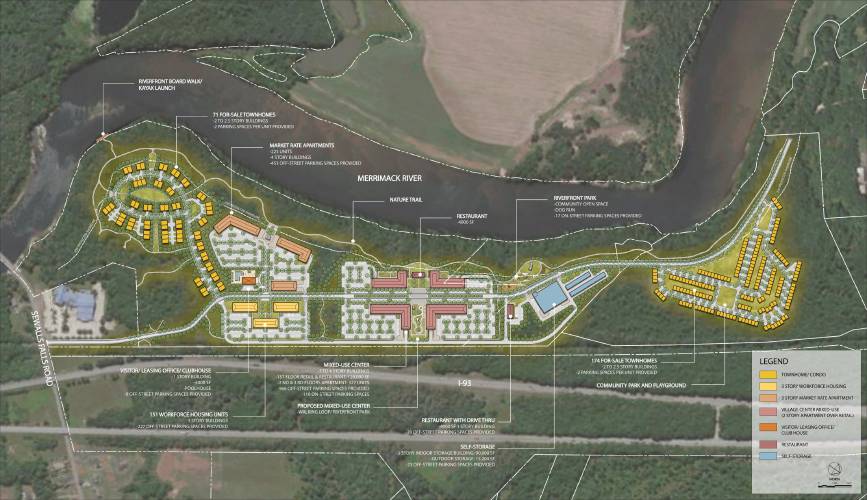Everybody wants workforce housing but what exactly is it?
| Published: 03-30-2024 10:00 AM |
Urban planners talk a lot these days about the need to support the “missing middle.” They’re talking about building size – more than a house, less than a high-rise – but they could be talking about income size.
For decades the free market has concentrated on single-family homes that are increasingly too expensive for many, while government assistance has concentrated on vouchers or other ways to help low-income people get housed. That has left a shortage of apartments, townhouses and homes within reach of what might be called the missing middle, the folks with a regular income who are better off than poor but far from rich.
Enter “workforce housing,” a term that crops up often these days even though it’s not always certain what it means.
“There’s a legal definition but this whole notion of workforce housing is bigger than that. …. It’s not a building definition but a human definition – not what is workforce housing but who is workforce housing,” said George Reagan, director of community engagement for New Hampshire Housing.
The term is often used to describe places accessible to households making between 60% and 120% of the local median income, which in New Hampshire reflects an annual income roughly between $50,000 and $110,000, although it varies widely throughout the state. This definition, however, is far from set in stone and depends upon the financing mechanism in use or even local regulations.
It differs from “affordable” housing, a term that usually means rent is no more than 30% of a household’s gross income.
The idea behind all the definitions is to help people with jobs like daycare worker, nurse, cook, driver, accountant – all the myriad tasks that society depends upon – have a place to live nearby. The hard part is to create housing that’s desirable while keeping an overheated market from sending the price into the stratosphere.
Consider Monitor Way, the huge mixed-use development targeted for north Concord. Among the roughly 600 apartments, townhouses and condos in the proposal are 151 units labeled as workforce housing. This means just what it sounds like, said developer Kevin Lacasse.
Article continues after...
Yesterday's Most Read Articles
 Concord may finally buy long-closed rail line with hopes of creating city-spanning trail
Concord may finally buy long-closed rail line with hopes of creating city-spanning trail
 Free speech group, residents back Bow parents’ free speech appeal in case involving transgender athletes
Free speech group, residents back Bow parents’ free speech appeal in case involving transgender athletes
 New Cheers owners honor restaurant’s original menu while building something fresh
New Cheers owners honor restaurant’s original menu while building something fresh
 ‘Perfect fit’: Fabulous Looks Boutique shifts leadership, preserving brands and styles
‘Perfect fit’: Fabulous Looks Boutique shifts leadership, preserving brands and styles
 Ayotte vetoes bathroom bill, defeating it for second time in two years
Ayotte vetoes bathroom bill, defeating it for second time in two years
“It is affordable housing, but affordable for those that work,” said Lacasse. “They have to make a certain level of income, a minimum, to be considered but there are also maximum income limits as well. So a doctor making a ton of money wouldn’t qualify.”
Lacasse used assistance from the New Hampshire Housing Finance Authority to lower his costs so he could lower prices.
The Housing Finance Authority is a self-supporting public corporation that was created by the state legislature back in 1981. Initially, it focused on low-income housing but in the past two decades, as single-income families have become less able to buy a house, it has expanded into workforce housing.
The Finance Authority, which has a board appointed by the governor but receives no taxpayer money, channels and supports a number of federal and industry programs that lower developers’ costs of building some housing, usually via tax credits or low-cost loans, in return for them lowering the purchase price or rents.
The complication is that the programs are linked to income, which requires verification and slows things down compared to the free-for-all of market-based housing. The rules can be complicated. For example, it’s generally the case that a renter can’t be forced to move out if their income rises above the maximum, but as income guidelines rise over time, new renters can be forced to pay more than existing tenants.
“When you get the funds, you have to income-qualify all the residents going in. It may require annual re-certification of all residents,” said Lacasse. “Every year it’s audited, the financials are audited by third parties.”
Disagreements – and there are always disagreements when money and regulations are involved – can go to the state’s Housing Appeals Board or even to Superior Court.
Even the biggest fans of workforce housing regulations admit that it would be better if they weren’t necessary, and the housing market as a whole did a better job of keeping a variety of options available for a variety of households.
“The lack of naturally occurring affordable housing is at the base of all this,” said Reagan. “If you have more supply in numbers and variety, you’re going to naturally have workforce housing.”
He pointed to some hopeful signs, including increased action at the town and state level, such as looser zoning regulations and the push to allow accessory dwelling units, once called “in-law apartments,” on existing properties. “Communities really do want to change things. … They understand the problem.”
Even so, he said, modern economics remains an obstacle.
“We really do struggle with the inflated cost of materials, labor, just the sheer demand for housing … and the cost of financing,” Reagan said.
Another, more subtle, issue is the public image of housing with any kind of government oversight, said Lacasse. In people’s minds, it can get lumped in with rental vouchers or other kinds of what is loosely considered “low-income housing,” creating an image of undesirable neighbors.
“A lot of it is getting the word out, dispelling the myth of what people assume what it is,” Lacasse said. “A similar myth is mobile homes. People think of them as tin cans on wheels, parks on top of one another, and don’t know about (modern) manufactured housing … I think it’s the same kind of idea with workforce housing.”
Failing to solve the problem will hurt everybody, he said. “We need these services performed. If people who do them can’t live in our area, they won’t happen.”









 ‘A little piece of everything I like’: New Pittsfield barbershop brings more than a haircut to downtown
‘A little piece of everything I like’: New Pittsfield barbershop brings more than a haircut to downtown NH judge decides to pause Trump’s birthright citizenship order
NH judge decides to pause Trump’s birthright citizenship order Canterbury honors ‘real heroes’ with updated Military Veterans’ Project
Canterbury honors ‘real heroes’ with updated Military Veterans’ Project Look, up in the sky! It’s… an Airstream trailer?
Look, up in the sky! It’s… an Airstream trailer?
